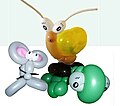Balloon modeling
Ballonmodellieren ( balloon twisting , Ballonage , balloon art ) the forms of special long, thin balloons connect to figures of all kinds. People balloon figures, called Twister or balloon artists .
By twisting the inflated modeling balloons, air chambers are created within the balloon and thus individual segments of the planned figure. For example, they make up the head, stomach and legs of a dog. Depending on the imagination and skill of the balloon artist, a wide variety of sculptures can be formed - contrary to the common term "balloon animal", not only animals, but also plants, vehicles and other figures.
Modeling technique
The modeling techniques range from design forms with only one balloon to modeling with several balloons. Complex techniques have evolved, as well as a special vocabulary to describe the technique used and the result achieved.
Some twisters inflate their own balloons, which has been standard and part of the concept for many years. Today air pumps are used more often. The balloons are usually not filled with helium , as the figures usually do not need to float and the material is too porous for helium. The creations are also often too large in comparison to the filling volume for helium to carry them.
Balloons
The balloons commonly used for balloon modeling are denoted in inches , e.g. B. "260", which is 2 inches in diameter and 60 inches in length (approx. 5 cm × 150 cm). There are also other sizes and shapes. The most popular brand is Qualatex from the Pioneer Balloon Company (USA). A lot of other balloon manufacturers are on the market with their products, so that today you have a large selection of different sizes, colors and shapes.
History of balloon modeling
Balloon modeling probably began in the United States around 1920 as part of animation show programs. The first mentioned in writing is a certain Mister HJ Bonnert from Scranton, Pennsylvania, USA, who modeled with balloons at a magician's meeting in Pittsburgh in 1938.
The modeling of figures from just one balloon probably goes back to the Englishman Wally Boag, with the stage name Windy Blow from 1945. In February 1953, he published a detailed description of a one-balloon animal figure in Max Andrew's Magic magazine.
After 1945, long thin balloons were first made in Japan and imported to the United States in bulk at a very low price. Simple instructions on the packaging showed how dogs, giraffes, hats, airplanes, etc. could be made from them. However, the quality of the rubber was so poor that few could follow the instructions without destroying the balloons. In addition, due to their material and shape, the balloons were very difficult to inflate. Still, they quickly became a commercial success in the United States. American companies took up the idea and began to market their regular Zeppelin balloons as modeling balloons. For example, there were packs for making a balloon dog with three short and one long balloon each.
In the late 1950s, some manufacturers in the United States began producing the modeling balloons that are still in use today. The quality of the material has been considerably improved, the colors are now brighter, and the balloons can also be inflated more easily. They were also a lot cheaper than the zeppelin balloons that had been in use until then, and their new length opened up new scope for design.
Balloon artist
A balloon artist is an artist who creates figures by modeling balloons as part of an entertaining demonstration. Balloon artists are mainly used for entertainment for children. You can often find a balloon artist as an entertainment program at business events such as the opening, open house , trade show or trade fairs.
Picture gallery
literature
- Holger Ewert, Peter Sendtko, Klaus-Peter van der Wingen: Learning to play modeling balloons , Edition Aragorn, Moers 1993, ISBN 3-924690-73-1 .
- Linda Perina: Magic with balloons , Frech Verlag, Stuttgart 2004, ISBN 3-7724-3319-7 .
- Ralf Esslinger: Balloon Art with Ralf , Frech Verlag, Stuttgart 2011, ISBN 978-3-7724-3913-1 .







